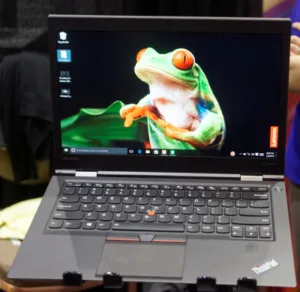We managed to squeeze into the Samsung Display suite at the end of its sessions and we had to speed around, as the exhibition contractors started dismantling the displays at 5:30 on the dot on Friday. The company also banned cameras, so we had to scribble frantically and are short of images!
The focus in large displays was, of course on LCD, rather than the push by LGD on OLED. We started by looking at a 98″ panel that is being developed with UltraHD as well as 8K.
Samsung has been working on improving its contrast ratio and had a new 65″ UltraHD VA panel that is intended for mass production in April, that raises the native contrast ratio to 6,000:1, before any backlight modulation. We couldn’t find out exactly how this was being done, but staff thought it was based on an improvement in LC alignment. The target for contrast is 8,000:1. (Clearly, the better the native contrast ratio, the easier it will be to meet the 20,000:1 [effective] contrast needed to meet the Premium label from the UltraHD Alliance – Man. Ed.)
Next we looked at a “Docking TV” concept that Samsung Display has been working on. In this system, a base has a channel with a connector and the display is placed in the base to form a complete TV. Samsung showed this with a curved LCD and explained how it could allow a single base to be used for a range of different panel sizes. The idea could also allow “mix & match” swapping of different chassis configurations and panel sizes and types.
Samsung has been working on its Gate in Panel (GIP) driving technology and the system was being shown on a 78″ UltraHD panel with narrow bezels. Staff told us that Samsung has been working on implementing the system on its G7 fab to allow 40″ displays to be made in a “monocut” process, which allows better efficiency. Also in driving, the firm had its MB7 concept for column drivers which reduces the number of drivers by 66%. (Staff couldn’t tell us much about this, but we found this article from the Journal of Information Display that talks about it http://tinyurl.com/grnlxbj)
OLED Rules for Small Panels
Turning to small/medium panels, AMOLED was being shown and new driving modes are being developed, although staff told us that the modes were already included in the Galaxy S6. The firm is also working on legibility in high ambient conditions and was showing a new OLED that could produce 600 cd/m² of output to match the performance of LCDs in these conditions.
Of course, Samsung was showing the 13.3″ and 14″ OLEDs that were in the notebooks shown at CES. The 13.3″ panel provides 300 cd/m² of output, 2560 x 1440 resolution, and a wide colour gamut. Bezels are 3.3/3.3/2.9/7.6mm and thickness is just 1.95mm including the cover glass which is 1.05mm thick). The weight is 258 grams in total or 110 grams without the cover.
Lenovo showed the X1 Yoga with an optional OLED display from Samsung. Image:Meko
The 14″ has bezels of 4.3/4.3/3.3/7.6 and is 1.76mm thickness with 230 grams of weight (the cover glass was thinner and the panel on its own slightly heavier than the 13.3″).
An LCD with very low weight was shown. It is a 12.3″ device with 3K x 2K resolution that means 267ppi. The thickness of the LCD is just 0.99mm and the weight is just 82 grams. The panel is made using thicker glass and is then thinned to the final size.
We asked about in-cell touch, but Samsung said that it is not shipping the technology and believes that on-cell is more flexible.
Also on display was the 30″ UltraHD panel used in the Dell OLED monitor shown at the show. The panel has 147ppi and has peak brightness of 200 cd/m² with more than one million to one contrast and 97% of AdobeRGB gamut.
We got a quick look at a new OLED with 800ppi that has been specifically designed for V/R glasses where there is high magnification of the image. The display is unlikely to be used in smartphones or other devices, but kept for dedicated use in headsets. There were few details, but diagonal looked around 5.5″.
Docking Monitor Concept Proposed
Samsung has also developed the docking concept that we saw for TV for desktop monitor applications. Again, the idea is to allow the mixing and matching of different panels and sets of electronics to reduce the range of inventory needed.
Also on display was a 23.8″ panel that could be built into an 18W monitor that could be powered by USB Type C from a notebook. The company also had a new “frameless” range of monitor panels that are available in sizes from 23.8″ to 27″ and with 5.93mm bezels on three sides, with 6.67mm along the bottom.
We had just seen the latest 3M privacy filters when we went to Samsung and the firm was showing a similar concept using collimated light from the backlight of the panel to limit the viewing angle of the panel. This was a technology demonstration and the firm was looking to get feedback to see if it was of interest to customers.
The latest version of the transparent 55″ OLED was being shown and it has now reached 45% transparency.
Finally, we had a brief look at some 7.1″ and 12.3″ LCD displays for automotive applications as the dismantling started!
Analyst Comment
We asked about the 1.4mm bezel video wall panels that Samsung Electronics had been showing on the main floor and we heard that the panel is already going into mass production. (BR)

